Heading Up and Down the Bays, and Washed Out to Sea
July 14-17, 2007
Getting up at 0630 on the 14th was a treat since the original plan called for a 0100 wake-up call. Since our coastal run was scratched we will have a short day (7 hrs) to get to our anchorage at Sandy Point at the mouth of the Great Wicomico River. After anchoring, Wayne and Eddie decide to get out the old alternator to replace the one we are operating with now since it has been discovered it is not putting out ANY voltage now, and our batteries are almost dead. They can't make the change over until everything cools down when we turn off the engine after we anchor. I decide to make brownies and vacuum the inside of FLUKE. The old alternator change over proves to be successful; even though we will have less output, it will be better than zero. We will have the alternator checked when we get to a convenient land base. Looking through the binoculars towards the shoreline I can see a 10' tall carving of a pilgrim that looks like it was made out of a gigantic tree trunk. Fascinating, as it is private property and not a park.
Calm waters of July 15 allowed me to work on the blog while underway to our destination in the Rhode River, south of Annapolis, MD. The Rhode was so crowded with both sail and power boats. However, one of the nice things about that river is it has a "through" section of the waterway designated as a float free zone. The Chesapeake is notorious for crab traps and their buoys making navigation very difficult in some areas. Whoever managed to get the float free zones created has done a real service for safety and enjoyment of the waterway. We would like to see more of those zones, especially in Maine.
Early the next day we passed the picturesque Thomas Point Light and then slowly cruised under the huge William P. Lane Memorial Bridge (Land Rt. 50/301). It is the only full bridge connecting both sides of Chesapeake Bay so has to be high enough for all the military and commercial ships to go under. It sure looks a lon . . . .g way up as we go under!
It must have been Demolition Day at the Aberdeen Proving Ground where the Army does ordnance testing. There was one explosion after another, varying in amount of noise and smoke plumes produced, as we passed by. There are "guard" boats stationed out in the waterway making sure that no one can get to close to "ground zero".
We dropped anchor just inside the mouth of the Bohemia River, west of the beginning of the C&D Canal, early enough for Eddie to go for a float behind the boat. He puts out a line with a float to hold onto and the current pulls him back out behind the boat. He can flounder around in the water or sit on the float. The big deal about this is that this is one of the rare areas in the Chesapeake "back" waters people can swim without having to worry about sea nettles stinging them. We have seen numerous types of jellyfish at several of the anchorages we have visited. Some of them have tentacles a couple of feet long!
We are entertained watching 3 people crabbing right next to us. Using a small skiff, they run out a line about 100 yds long with an anchored float at each end. A piece of bait is securely attached to the line about every 10 yds. Starting at one end the line is lifted out of the water and the boat is driven alongside the line. As the line comes up out of the water, hopefully with a crab grabbing the bait, a person with a metal net scoops the crab off and dumps it in the boat. When the boat gets to the other end, they turn around and go back to the beginning. By the time they begin lifting the line more crabs have gone after the bait again. We were impressed with how many crabs they were catching in a short period of time.
We could see weather conditions were building up for some rain and fog, so we weren't surprised to wake up on July 17 to a foggy sunrise. With visibility less than 100' in some places and the current against us, traveling through the sometimes restrictive C&D Canal was a slow venture. We relied on our radar to look for other ships (those coming from behind are just as worrisome) and hailer siren to provide an audible warning.
Fortunately when we entered Delaware Bay most of the fog had lifted, the Bay was calm, and traveling just outside the main shipping channel (this is done to give the BIG commercial ships all the room), we made good progress towards the Atlantic. In fact, with a weather forecast of only patchy fog, mild winds and mostly calm seas we made the decision not to stop at Cape Henlopen and just keep going all night up the coast of New Jersey to beat what looked like impending foul weather.
The wind and sea conditions proved to be true to the forecast, but the fog was not patchy within the 10 or less miles we traveled from the coast; it was socked in. We kept thinking that we would get out of it, but as the twilight waned it stayed with us. This was to be our first experience with traveling in the fog at night. Night travel at sea is challenging enough in my book, but the fog added a whole new fear.
I had the first watch, from 2000-0045. The foggy black of night disoriented my depth perception. Even though I had the radar and electronic chart to guide me it is still an unsettling feeling not to actually see a target. I tracked a boat for 4 miles that was slowly angling towards our course and felt comfortable that it was seeing me too by its course line, but I couldn't see it until it was less than 1/4 mile away when I saw that it was a fishing boat with nets out. If it had been a boat traveling at twice our speed I would have been very nervous since that short distance would have been passed quickly.
In fact, at 2230 I had a marker buoy coming up that I could see on radar and on the chart. When I could finally see it flashing through the fog I felt we were going to be too close and turned the boat off course. I had difficulty orienting myself and had to wake up Wayne to come help me. Eddie woke up too. I felt so bad disrupting their sleep! Little did I realize what they were going to do to me when it was my turn to finally get some much-needed rest.
At 0345 I was awakened to a loud grinding noise coming from the aft section of FLUKE, and the boat was getting bounced around quite a bit, not like when I left the helm and the seas had been calm. I thought we had hit something with the prop. I could hear Eddie yelling up in the pilothouse. I ran upstairs to see the guys staring out at a commercial fishing boat that had crossed right in front of our bow. Wayne had put the boat in reverse to bring her to a stop to avoid a collision. Even though they had tracked the boat for quite a ways, and we had the right-of-way, the other boat had not yielded. They had misjudged the distance it would take to alter course to avoid the other boat by a comfortable margin. Another lesson learned a frightening way. It was difficult to go back to sleep after that!
The fog stayed with us all the way up to Sandy Hook at the northern tip of New Jersey where we would make the turn to head up into busy New York harbor. With visibility being so poor, and the air feeling like impending rain, we decided to hold off going into the harbor until the conditions improved. Having to deal with the fast moving NYC ferry traffic in the fog wasn't what we wanted to practice. Plus, it gave us a chance to check out the Horseshoe Cove anchorage which we had never been to and wanted to find out if it would be suitable to use after the NJ coastal run in the future. We had the anchor down at 0800 and breathed a sigh of relief.
Tuesday, July 24, 2007
Subscribe to:
Post Comments (Atom)
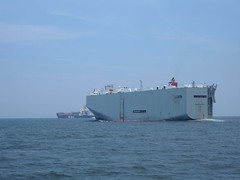
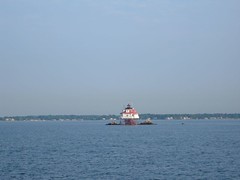
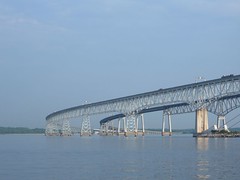
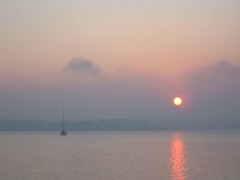
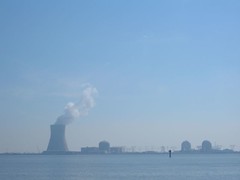








0 comments:
Post a Comment